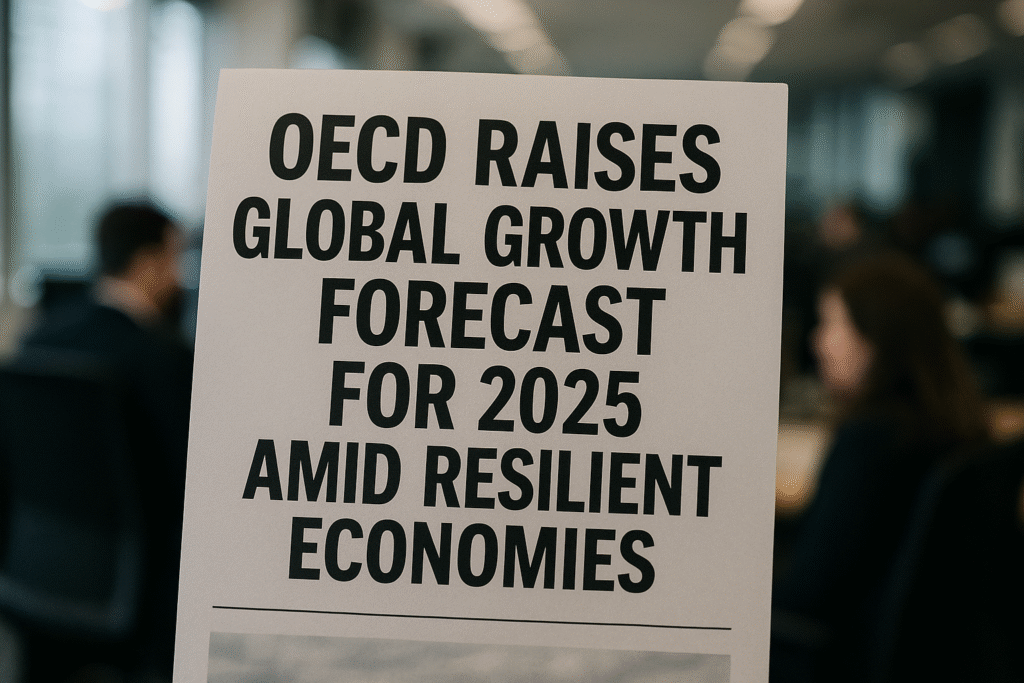By Harshit | September 23, 2025 | Washington, D.C. | 11:45 AM EST
Global Economy Shows Unexpected Strength
The Organisation for Economic Co-operation and Development (OECD) upgraded its global economic growth forecast on Tuesday, citing unexpectedly resilient performance in several major economies. The organization now projects the world economy will expand 3.2% in 2025, up from the 2.9% forecast issued in June. Growth for 2026 remains at 2.9%, slightly below the 3.3% expansion seen in 2024.
“The first half of 2025 showed stronger-than-expected growth, particularly in emerging markets,” OECD officials said in their latest report, highlighting industrial production and trade gains, as well as robust AI-driven investment in the United States.
U.S. Growth Outlook Improved
The OECD revised U.S. growth projections upward to 1.8% for 2025, up from June’s 1.6% estimate, though this still represents a notable decline from 2024’s 2.8% expansion. “Strong AI investment and fiscal measures have helped buffer the economy,” said Alvaro Pereira, chief economist at the OECD, during a CNBC interview. He added that emerging markets, including Brazil, Indonesia, and India, also contributed positively to global growth.
Despite the optimism, Pereira cautioned that growth may slow in the latter half of the year due to front-loaded production and trade activity earlier in 2025.
Tariffs Pose Ongoing Risks
While the economic outlook has improved, the OECD warned that elevated tariffs and policy uncertainty continue to pose significant risks. The report noted that sweeping U.S. duties implemented in August have pushed some bilateral tariff rates to nearly 50%, the highest since 1933.
“The full impact of tariffs has yet to be felt,” the OECD stated, noting that companies initially absorbed some cost increases through profit margins, but rising prices are increasingly influencing consumer spending, labor markets, and overall inflation.
Pereira said, “The tariff shock is contributing to inflationary pressures in multiple economies, not just the U.S., as global supply chains adjust.”
Inflation Trends and Labor Market Signals
The OECD now forecasts headline inflation across G20 nations to average 3.4% in 2025, slightly below June’s 3.6% estimate. In the United States, projected inflation has been revised down more sharply, to 2.7%, from 3.2% previously.
Labor markets are showing signs of softening, with unemployment rising slightly in certain countries and job openings declining. Economists caution that persistent tariff pressures may exacerbate these trends and affect wage growth.
Expert and Community Reactions
Economists and market analysts noted that while the revised growth projections are encouraging, businesses remain cautious. “Short-term optimism is good, but companies are bracing for continued uncertainty in tariffs and trade policies,” said Laura Chen, a global macro strategist at Horizon Investments.
Small business owners echoed these concerns. Javier Morales, owner of a U.S. import-export firm, said, “The tariffs have already affected our pricing strategy. Even if global growth looks stronger, we’re worried about additional costs hitting later this year.”
Forward-Looking Implications
Looking ahead, the OECD emphasized that the global economy remains vulnerable to policy shocks, renewed inflationary pressures, and potential financial market repricing. Analysts expect that trade negotiations, tariff adjustments, and fiscal responses will be critical in shaping growth trajectories over the next 12–18 months.
“While the revised numbers are encouraging, policymakers and investors should remain vigilant,” Pereira noted. “Global growth is resilient, but risks are mounting as uncertainties continue to affect trade and investment decisions.”






